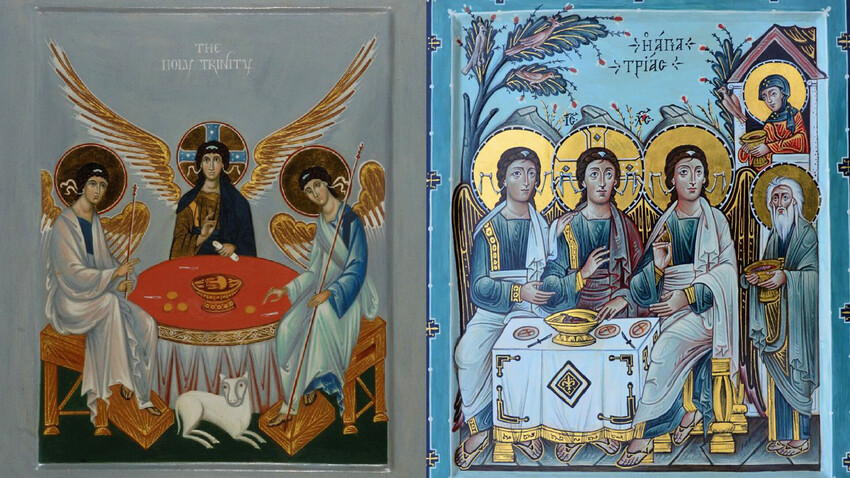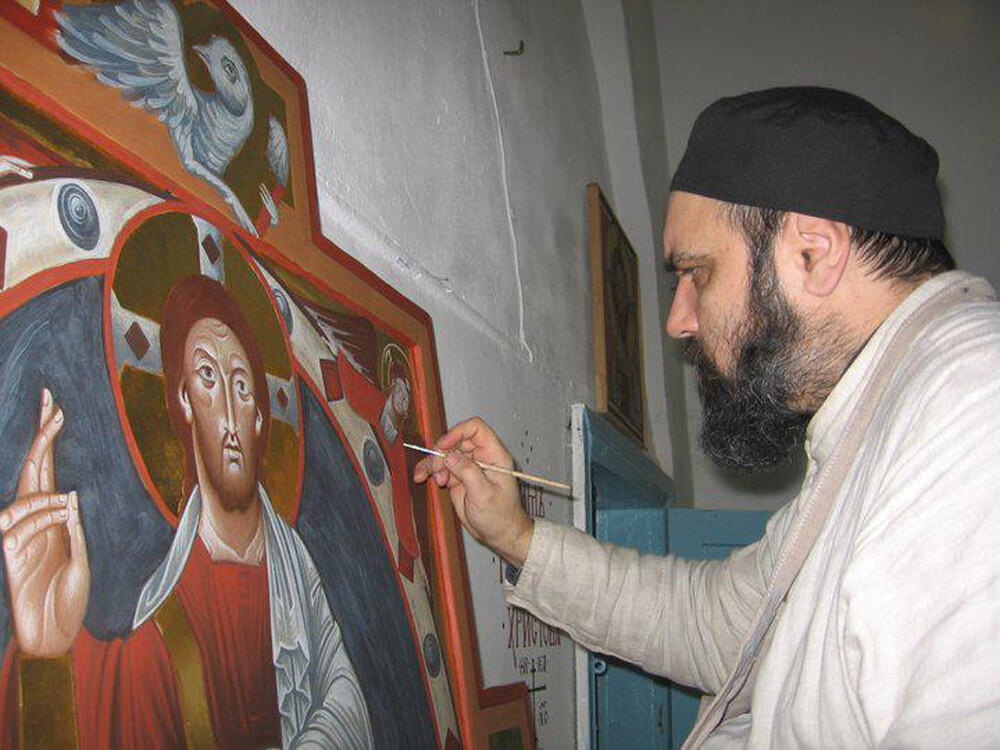
Vladimir Teodor became interested in icon painting while he was still a student at art college. At first, he copied old images in his studies, and did his own research into their canons and painting techniques. In the late 1970s he took his monastic vows at the Pskov-Pechersk Monastery.
Father Zenon decorated churches in the Trinity Lavra of Saint Sergius and the Danilov Monastery, as well as in churches in Italy, Belgium, Austria, France and Finland, and the Simonopetra Monastery on Mount Athos in Greece. In Saint Petersburg, he frescoed the lower church and painted icons for the Feodorovskaya Icon Cathedral in commemoration of the 300th anniversary of the House of Romanov. He also decorated the Church of Saint Sergius of Radonezh and the Chapel of the Beheading of Saint John the Baptist built on the site of the assassination of Archpriest Alexander Men in a village outside of Moscow. A follower of the Byzantine tradition in religious painting, Father Zenon was one of the first to return to the use of the encaustic technique.
A graduate of the Moscow Art Theater School and a stage designer, Andrey Davydov developed an interest in icon painting in the late 1970s. In 1986, he became a priest. He painted icons for the iconostasis, as well as frescoes for the ancient Church of the Nativity of Saint John the Baptist in Pskov.

Since 2007 he has been the archpriest of the Saint Nicholas and Nativity of Christ churches in Suzdal, where he also has an icon-painting workshop teaching the technique of painting on wet plaster. Like Archimandrite Zenon (whom he met while working on the frescoes at the Danilov Monastery), Father Andrey also uses the encaustic technique. He regards icon painting as a contemporary art form that allows him to realize all his creative ideas.
A graduate of the Moscow State Stroganov University of Industrial and Applied Arts, she became an Orthodox believer in the early 1990s and soon developed an interest in icon painting. Together with her husband, sculptor Sergei Antonov, she painted the altar screen and her first icons for the Church of Saint Nicholas in Golutvinsky Lane in Moscow. She painted them on cardboard so that church services could be held there as soon as possible.
Interestingly, one of the side chapels of the church was consecrated by Saint Philaret - Irina painted one of the first icons of this saint, which now contains a fragment of his relics. For inspiration, the artist often visited the State Tretyakov Gallery and spent a long time looking at ancient images. For her wall paintings in the Church of the Holy Martyr Antipas in Kolymazhny Dvor in Moscow, Irina was awarded the Gold Medal of the Russian Academy of Arts. Also, together with her husband, Irina frescoed the Gate Church of Saint Andrew's Monastery in Moscow.
The son of a priest, Andrei Davydov, Philip learned the skill of icon painting from his father. He believes a sacred image should be an "incentive for contemplation", so that a modern person pays attention to it and doesn't just walk past. Davydov and his wife Olga founded an icon-painting studio in Saint Petersburg.
Philip painted frescoes for the Church of Saint John the Evangelist in New Brunswick (U.S.), and murals and mosaics for the altar and sanctuary of the Church of Saint Leonidas in Ilyichevo (Leningrad Region). Olga works in different techniques and makes processional church banners and shrouds.
The artist became interested in icon painting in the mid-1980s after meeting Archimandrite Zenon, and helped with his frescoes for the Danilov Monastery. Chashkin produced his first independent work in 1988 in the run-up to celebrations of the 1,000th anniversary of the Baptism of Ancient Rus - fresco paintings in the style of the 16th-17th centuries for the Church of Saint Nicholas in Kochaki.
This is the church in which Leo Tolstoy was baptized. His icons and frescoes can also be found in the Iverskaya Chapel on Red Square, in the Church of Saint George the Victorious on Poklonnaya Hill in Moscow and Saint Nicholas Cathedral in Washington D.C.
In 1990, the Gretkys bought a plot of land in the village of Akulova Gora in the Leningrad Region where the ancestral estate of the artist Vasily Polenov once stood. On this spot, they built the Church of Saint Basil the Great in the Old Russian style and painted icons and frescoes.
This was their first experience in religious painting: They were guided by examples of medieval Novgorod icon painting. The work of Irina and Yury Gretsky can be seen in the church of the Syandema Convent of the Dormition (Republic of Karelia in North Russia).
Sokolov's first encounter with icon painting came when, at the age of 14, he saw the icon of Christ the Redeemer (the so-called Zvenigorodsky Chin, attributed to Andrei Rublev) at the State Tretyakov Gallery. A few years later after he was baptized, he thought about painting an icon and made a copy of the image of Saint Paraskeva from the Cathedral of the Intercession at the Rogozhskoye Cemetery.
In 1993, Sokolov painted an image of the Mother of God titled “The Inexhaustible Chalice” for the Church of the Intercession at the Vysotsky Monastery in Serpukhov. It is considered to be a miracle-working icon. The artist also painted frescoes in churches including Saint Panteleimon in Sukawa (Japan).
Once a member of the workshop of Non-conformist artist Vasily Sitnikov, in the mid-1980s Lavdansky abandoned secular painting and concentrated on icon painting. Interestingly, the artist re-adopted a principle followed by icon painters of past centuries - working as part of an artel (association of artisans or artists) in which each member performs a particular task. This enabled the fresco work to be executed rapidly while at the same time maintaining a uniform style.
His icons and wall paintings are now in the Church of the Holy Fathers of the First Seven Ecumenical Councils at the Danilov Monastery, the Church of All Saints at Kulishki, and the Church of the Three Holy Hierarchs at Kulishki. He also works abroad: He helped make the frescoes at New York City’s Saint Nicholas Church in Whitestone and the Holy Trinity Church on Long Island.
He received the blessing to pursue icon painting from Archimandrite Zenon. At this time he met Alexander Lavdansky, with whom he subsequently worked on frescoes at the Church of the Life-Giving Trinity in Khokhly.
Eyteneyer painted images of the Vladimir Mother of God, the Old Testament Trinity and the Intercession of the Mother of God, as well as a Passion series, for the same church. The artist has also painted icons for the Church of the Trinity in Nikitniki.
This artist began learning the technique of icon painting in the mid-1980s and studied under Ksenia Pokrovskaya, a devoted follower of the restorers of the Trinity Lavra of Saint Sergius. Olga painted iconostasis for the Church of the Icon of the Savior Not Made By Hands in the village of Nikulino in the Moscow Region's Podolsky district; as well as the iconostasis in the Church of the Transfiguration of the Lord in Tushino, and the iconostasis in the Church of the Intercession of the Mother of God at Butyrka Prison.
Dear readers,
Our website and social media accounts are under threat of being restricted or banned, due to the current circumstances. So, to keep up with our latest content, simply do the following:
If using any of Russia Beyond's content, partly or in full, always provide an active hyperlink to the original material.
Subscribe
to our newsletter!
Get the week's best stories straight to your inbox